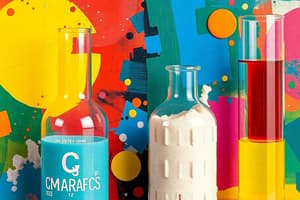Podcast
Questions and Answers
A scientist observes that a substance readily combines with another, producing a new gas. Which property is best exemplified by this observation?
A scientist observes that a substance readily combines with another, producing a new gas. Which property is best exemplified by this observation?
- Flammability, due to the production of a gas
- State of matter, gases demonstrate indefinite shape and volume
- Reactivity, indicating the substance's ability to combine (correct)
- Density, because gases have lower densities than liquids
A sealed container holds a fixed amount of gas. If the container is heated, what changes will be observed within the container, according to the kinetic theory?
A sealed container holds a fixed amount of gas. If the container is heated, what changes will be observed within the container, according to the kinetic theory?
- The gas will condense into a liquid, reducing particle motion
- The mass of the gas will increase due to the additional heat
- The volume of the gas will decrease as the particles slow down
- The movement of gas particles will increase (correct)
Consider an experiment where a block of ice at $-5^\circ C$ is gradually heated until it turns into steam at $105^\circ C$. Which of the following phase changes is endothermic?
Consider an experiment where a block of ice at $-5^\circ C$ is gradually heated until it turns into steam at $105^\circ C$. Which of the following phase changes is endothermic?
- Condensation, because heat is released
- Freezing, as heat is removed from the water
- Deposition, which involves a release of energy
- Melting, as heat is absorbed to change state (correct)
In a laboratory, a student mixes two clear liquids, resulting in the formation of a solid precipitate. This observation primarily indicates what type of change?
In a laboratory, a student mixes two clear liquids, resulting in the formation of a solid precipitate. This observation primarily indicates what type of change?
A jeweler suspects that a gold coin is counterfeit. Which of the following methods would be most effective to test if the coin is pure gold without damaging it?
A jeweler suspects that a gold coin is counterfeit. Which of the following methods would be most effective to test if the coin is pure gold without damaging it?
Flashcards
Properties of Matter
Properties of Matter
All matter must have mass and volume.
Law of Conservation of Energy
Law of Conservation of Energy
Energy cannot be created or destroyed, only transformed into different forms.
Difference between Pure Substance and Mixture
Difference between Pure Substance and Mixture
A pure substance has a constant composition, while a mixture can change in composition.
Physical vs Chemical Change
Physical vs Chemical Change
Signup and view all the flashcards
Kinetic Theory of Matter
Kinetic Theory of Matter
Signup and view all the flashcards
Study Notes
Matter Properties
- All matter has mass and volume.
Law of Conservation of Energy
- Energy cannot be created or destroyed; it can only change form.
Non-Matter Examples
- Light, heat, and sound are examples of things that exist but are not considered matter.
Pure Substances vs. Mixtures
- Pure substances have a fixed composition.
- Mixtures have a variable composition.
Heterogeneous vs. Homogeneous Mixtures
- Heterogeneous mixtures have visibly different parts.
- Homogeneous mixtures have uniform composition; the particles are not seen.
- Salad dressing is heterogeneous due to its different particle sizes.
- Salt water is homogeneous due to dissolved salt particles.
Determining the Composition of a Coin
- Density is the best way to determine if a valuable coin is actually made of gold (without damage) because it measures the mass-to-volume ratio.
Flammability
- Flammability is a chemical property that can only be tested when oxygen is present.
Reactivity
- Reactivity refers to how easily a substance combines with another.
Chemical vs. Physical Changes
- Physical changes affect the appearance of a substance but not its composition (e.g., melting ice, dissolving sugar in water).
- Chemical changes alter the composition of a substance (e.g., burning wood).
- Mixing vinegar and milk is a chemical change because a new substance is formed.
- Melting ice is a physical change because ice just turns to water, the same substance.
States of Matter
- Solids: Maintain a fixed shape and volume.
- Liquids: Take the shape of their container, maintain a fixed volume.
- Gases: Take the shape and volume of their container.
Kinetic Theory and Heat
- As objects are heated, their particles move faster. All objects have particles in constant motion.
Endothermic and Exothermic Phase Changes
- Endothermic: Melting, vaporization, and sublimation (energy absorbed)
- Exothermic: Freezing, condensation, and deposition (energy released)
Studying That Suits You
Use AI to generate personalized quizzes and flashcards to suit your learning preferences.




